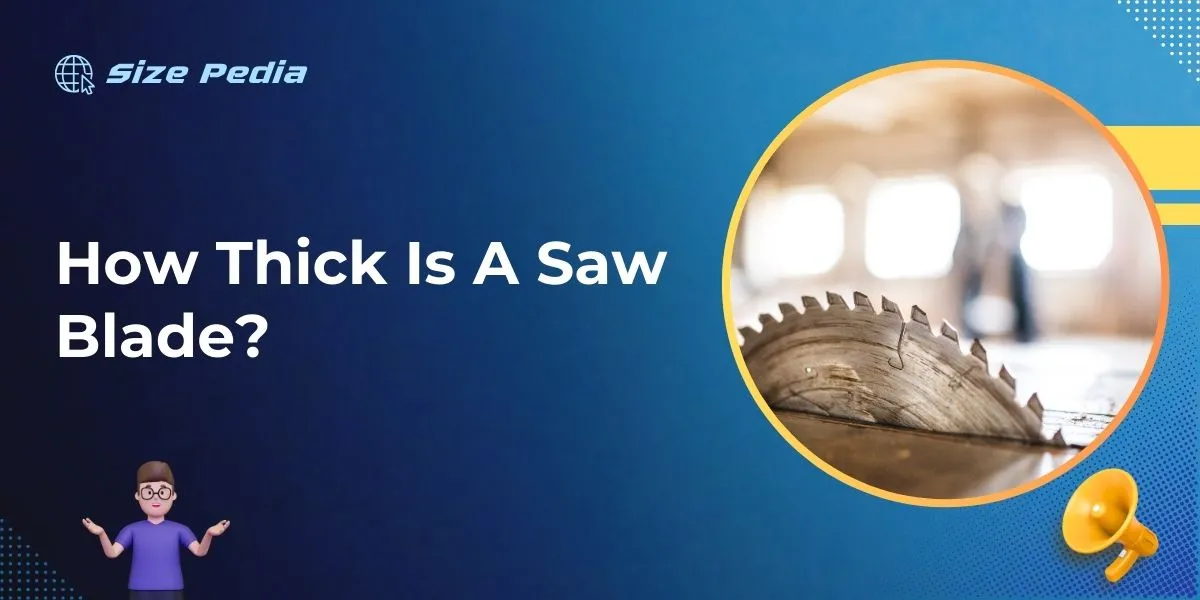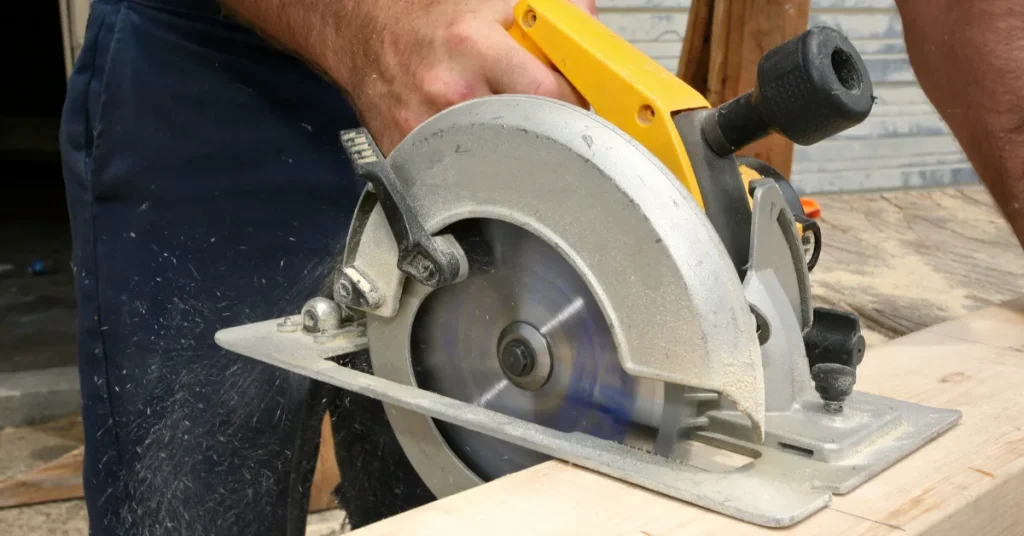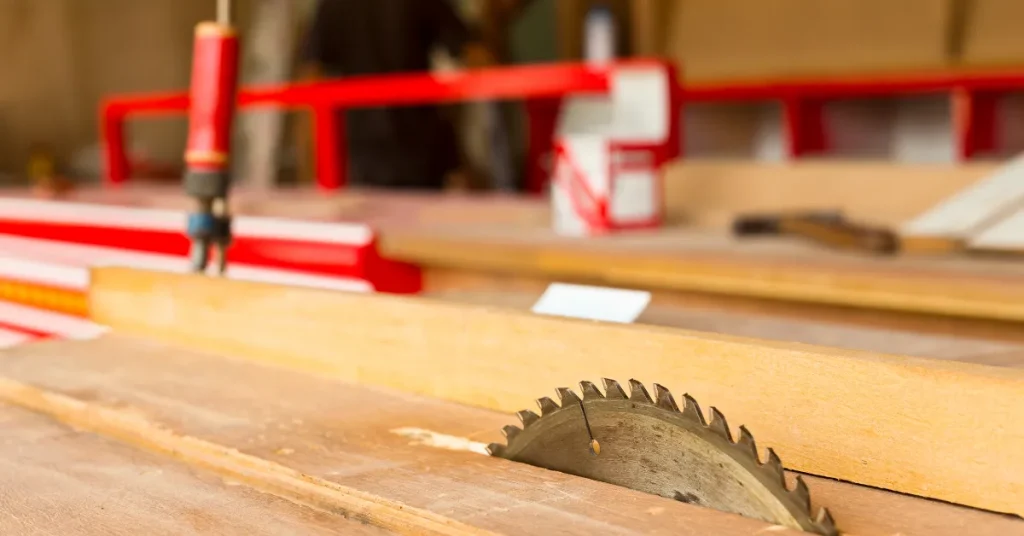The thickness of a standard saw blade typically ranges from 0.062 to 0.125 inches. Kerf, the cut width made by the blade, varies with blade thickness.
Understanding the specifics of saw blades is crucial for both professional and DIY projects.
The kerf directly affects the material loss during cutting and the smoothness of the final cut. Thicker blades tend to be more durable and can withstand tougher materials, but they remove more material.
On the other hand, thinner blades produce a finer cut with less waste and are perfect for delicate or precision work. It’s important to select the blade thickness that aligns with your project needs.
Doing so ensures efficient cutting performance, maximizes the blade’s lifespan, and can prevent unnecessary strain on your power tools. Equipped with this knowledge, you’re better prepared to choose the right saw blade for your next endeavor.

Cutting Through Confusion: Saw Blade Thickness Basics
Understanding saw blade thickness is key to effective woodworking. The right blade thickness affects the precision and quality of the cut.
Let’s dive into the essential knowledge of saw blade thickness. This guide will help clarify common questions woodworkers face selecting the perfect blade for their project.
The Role Of Kerf In Woodworking
Kerf refers to the width of the cut that a saw blade makes. It is critical for woodworkers as it determines the amount of material removed with each pass of the blade.
Thinner kerfs mean less material is wasted, while thicker kerfs can be more durable and easier to control. Here’s why kerf matters:
- Maximizes material: Using the correct kerf reduces waste.
- Enhances precision: A thinner kerf can lead to more accurate cuts.
- Saves energy: Blades with thinner kerfs require less power.
Standard Thicknesses Across Blade Types
Different types of saw blades come with varying standard thicknesses. This can be daunting to understand, but knowing these standards can simplify choosing the right blade. Below is a breakdown of common blade types and their typical thicknesses:
| Type of Blade | Standard Thickness |
| Circular Saw Blades | Typically 1/8″ to 1/4″ |
| Table Saw Blades | Generally range from 3/32″ to 1/8″ |
| Band Saw Blades | Can be as thin as 0.025″ |
| Scroll Saw Blades | Often around 0.02″ to 0.06″ |
Selecting the ideal thickness depends on your specific cutting needs and the precision required for your project.
Types Of Saw Blades And Their Unique Thickness
Understanding the thickness of saw blades matters for your cutting tasks. Different saw types have unique blade thicknesses.
The right thickness affects the cut’s accuracy and the tool’s longevity. Explore the world of saw blades. Each type stands out with its precise dimensions.
Circular Saw Blades: Standard Dimensions

Circular saw blades are vital for clean cuts across various materials. Unique jobs require specific blade sizes.
Most circular saw blades range from 1.8mm to 3.2mm in thickness. The kerf, or cut width, depends on the blade’s thickness. Here’s a quick look at common dimensions:
- Thin Kerf: about 2.2mm, less waste, faster feed rate
- Full Kerf: roughly 3.2mm, superior stability, longer-lasting
Band Saw Blades: Thin Vs. Wide
Band saw blades excel in both intricate and resawing tasks. Choose thin or wide blades based on your project needs. Thin blades, measuring about 0.5mm to 0.8mm, maneuver tight curves with precision.
Wide blades, close to 1mm thick, suit resawing with more stability. Consider these variations:
| Blade Type | Thickness |
| Thin Blades | 0.5mm – 0.8mm |
| Wide Blades | Up to 1mm |
Table Saw Blades: Balancing Strength And Precision
Table saw blades blend durability with meticulous cutting. Ideal thickness boosts the tool’s performance.
Most blades sit between 2.2mm and 3.2mm thick. This range guarantees a sturdy cut without compromising precision. Key points include:
- Standard Table Saw Blade: about 3.2mm, general use, good balance
- Thin Kerf Table Saw Blade: close to 2.2mm, less material loss, requires less power
Measuring Saw Blade Thickness
Measuring Saw Blade Thickness is crucial for precision cuts in woodworking and metalworking.
The thickness of a saw blade can influence the kerf and thus the material waste. Professionals and hobbyists alike need to know how to accurately gauge this measurement.
Tools For Accurate Thickness Measurement
Proper tools ensure precision when determining saw blade thickness. Here are some tools you might use:
- Micrometers: Provide highly accurate blade thickness measurements.
- Vernier Calipers: Offer versatile measurements of both blade thickness and kerf width.
- Thickness Gauges: Easy to use tools specifically designed for measuring blade thickness.
Measuring Kerf Width: Tips And Tricks
Measuring kerf width, the cut width created by the saw blade, requires precision. Reference these tips:
- Use a Fresh Blade: A new blade provides the most accurate kerf reading.
- Make a Test Cut: Cut into a spare piece of material to measure the kerf.
- Measure Immediately: Measure the test cut promptly to avoid variations due to blade wear.
Employing these methods results in precise blade and kerf width measurements, ensuring effective material use and project outcomes.
Impact Of Thickness On Cutting Performance
The thickness of a saw blade plays a pivotal role in its cutting performance. Understanding the impact of blade thickness can help you choose the right tool for your project.
Thickness Influencing Cut Quality
Finesse and precision in cuts often hinge on the saw blade’s thickness. Thick blades tend to offer stability and durability but can lead to more material being removed.
On the other hand, thinner blades can make more precise cuts with a finer edge.
- Thin blades cause less resistance and can cut intricate shapes well.
- Thick blades are better for straight cuts in tougher materials.
- Blade thickness affects the surface finish of the cut piece.
The Trade-offs Between Thick And Thin Blades
Each blade serves a particular purpose, and knowing the trade-offs can optimize your work.
Thin blades:
- Heat up quickly, which can shorten blade life.
- Can bend or wander during heavy-duty jobs.
Thick blades:
- Stay cooler during tough cuts, extending lifespan.
- Require higher power from the saw.
- Remove more material and produce thicker kerfs, potentially wasting material.
Selecting the ideal blade thickness is crucial for quality, safety, and efficiency. Consider the material, cut type, and saw capabilities before making a decision.
Maintaining Blade Thickness And Care
When working with saw blades, keeping them thick and well-maintained is key. A blade that keeps its thickness lasts longer and cuts better. Let’s discuss how to take care of your blades to ensure they remain in top condition.
Proper Storage Practices For Blade Longevity
Storing your saw blade correctly prevents damage and keeps it thick. Follow these tips:
- Hang the blade on a peg or a hook.
- Avoid stacking blades on each other.
- Use a storage case for protection.
- Keep the environment dry to prevent rust.
Sharpening Techniques To Preserve Thickness
Sharpening is essential for maintaining blade thickness. Here’s how:
| Technique | Benefits |
| Use a professional sharpener | Ensures even sharpening |
| Hand sharpening with care | Preserves blade thickness |
| Regular check-ups | Avoids over-sharpening |
Remember to sharpen only when necessary and use the right tools. This preserves the blade’s thickness and ensures a longer lifespan.
Selecting The Right Blade Thickness For Your Project

Ever wondered why your woodworking projects don’t turn out how you hope? Sometimes the secret lies in the saw. Picking the right blade thickness can make or break your work. Let’s dive into how to choose the perfect saw blade thickness for your project.
Factors To Consider When Choosing A Blade
Blade thickness matters in saw performance. You must think about a few things to pick the right one.
- Material: What will you cut? Softwood needs a different blade than hardwood or metal.
- Machine Type: Match the blade to your saw. Check your tool’s manual for specs.
- Cut Quality: Want a fine cut? A thinner blade could be best. Going for speed? Thick might be your pick.
- Stability: Thick blades wobble less. This means straighter cuts.
- Kerf Width: This is the cut width. A thick blade makes a wider kerf.
Common Project Types And Recommended Blade Thickness
Different projects need different blade thicknesses. Let’s match some common projects with their ideal blade thickness.
| Project Type | Blade Thickness | Reasons |
| Precision Woodworking | Thin | Fine, clean cuts. |
| Ripping Hardwood | Medium to Thick | Stability and speed. |
| Metal Cutting | Thick | Strength and durability. |
| General Construction | Medium | Versatility. |
FAQS About How Thick Is A Saw Blade
How Thick Is A Cutting Blade?
A cutting blade’s thickness typically ranges from 0. 02 inches (0. 5 millimeters) to 0. 125 inches (3. 175 millimeters), depending on its use and design.
How Thick Are Cut Off Saw Blades?
Cut-off saw blades typically range from 1/16 inch (1. 6mm) to 1/8 inch (3. 2mm) in thickness. Their width is designed to balance cutting speed with durability.
How Thin Is A Saw Blade?
A typical saw blade thickness ranges from about 0. 062 to 0. 094 inches, with variations based on the blade type and purpose.
How Thick Is The Plate Of A Saw Blade?
The thickness of a saw blade, commonly referred to as the kerf, varies but typically ranges from 0. 094 to 0. 156 inches for standard circular saw blades.
Conclusion
Understanding saw blade thickness is essential for any cutting task. Different materials and saw types demand specific blade widths.
Always consider manufacturer specifications and project needs. Choosing the right blade thickness optimizes your cutting precision and tool longevity. Equip yourself with this knowledge for successful sawing results.
Resources:
1. https://www.osha.gov/etools/machine-guarding/saws/table
